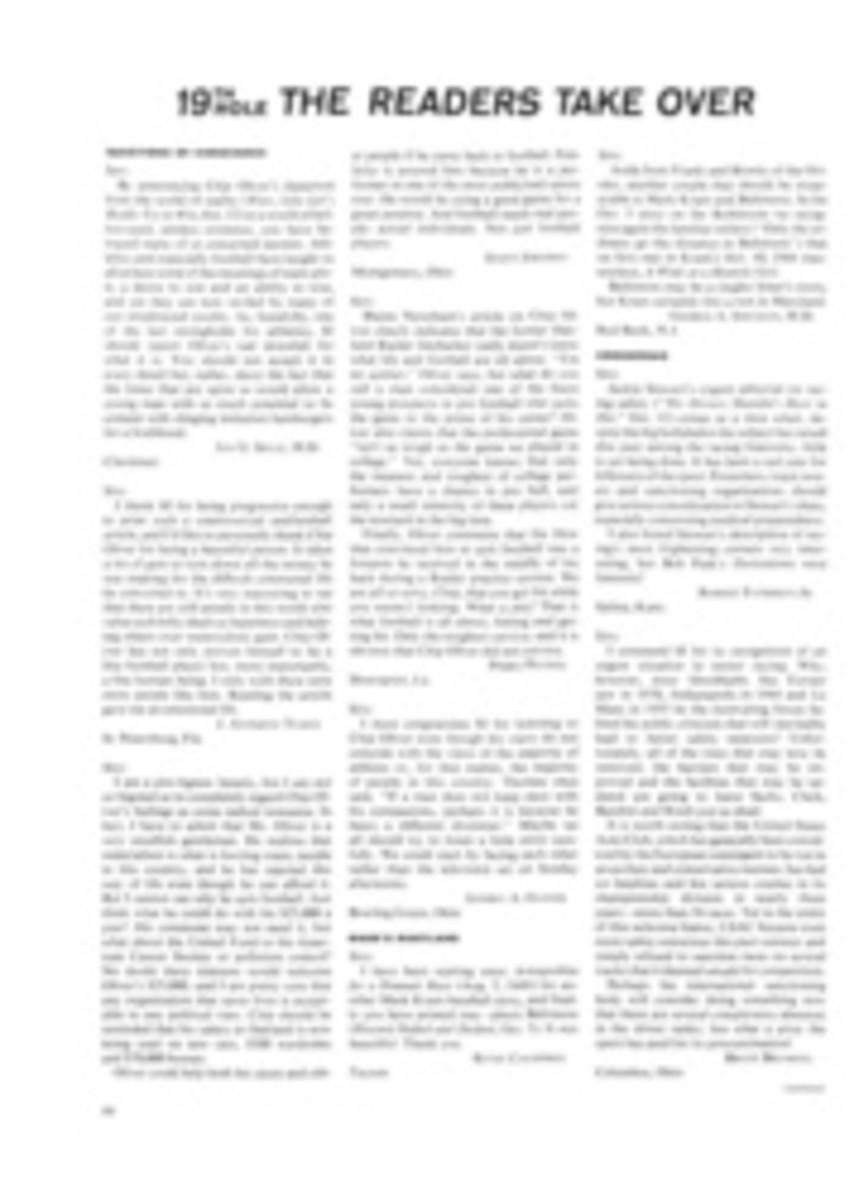
Self-defense, but no kickie, no squashie
If you should someday find yourself facing alone the simultaneous attack of five strong men and happen to have left your flamethrower at home, one of the things you might find useful is an expert's knowledge of aikido. A relatively new form of Japanese martial art, aikido is not a competitive sport like judo and karate, but it is a spectacularly effective method of self-defense. It looks ceremonious and downright unoffending, but a demonstration makes it plain that aikido has a utilitarian value: an expert aikidoist really can fend off the combined, unrehearsed onslaught of five antagonists. All that is required—besides prolonged training—is complete peace of mind during the attack, and a knowledge of how to turn his aggression against the aggressor.
Aikido looks simpler than it is, and no one can make it look less complex than Koichi Tohei, the highest-ranking—10th degree—aikido black belt in the world. Mr. Tohei glided quietly into New York recently to preside over an aikido seminar that lasted a week and drew more than 600 spectators to his final demonstration, leaving some of them perplexed but all of them fascinated. What perplexes is the total ease of the performing aikidoist; what fascinates is the obvious power.
There is little body contact in aikido. The man defending himself deals mostly with his assailant's arm or wrist, stepping out of the line of attack with upraised arms to block the intended blow, then using the attacker's own momentum to throw him, or as the aikidoist puts it, to "lead" him down. Leading may include an immobilizing pressure on the elbow or wrist but always, in the end, it is the force of the hips, not the strength of the arms or hands, that brings an opponent down. With its circular moves and long gliding steps—as opposed to the linear, head-on contact of judo or the short, abrupt thrusts of karate—aikido resembles nothing so much as a dance, a devastating dance, to be sure.
Relaxation is the key to aikido. Yoshimitsu Yamada, sixth-degree black belt and chief instructor at the New York Aikikai, said of Tohei, "He is like the center of a hurricane, perfectly still and relaxed, with everyone whirling about him trying to make contact."
Every three years or so, since the introduction of aikido into the United States via Hawaii, Mr. Tohei leaves his job as chief instructor at Hombu World Aikido Headquarters in Japan to visit his flourishing little foreign empire. His recent stopover in New York had followed a three-month teaching stint in Los Angeles. Then came Boston and Chicago, and back to Japan in time to pack for Korea, where a version of his art is being taught as hopaikido. "I go there by invitation," he said, "to get the hop out of aikido."
Aikido lends itself to demonstrations, rather than contests, for the winner, by the very nature of aikido techniques, is preordained.
"To win a contest," explains Tohei, "one must develop a fighting mind. In aikido, nage [the victim of an attack] must be completely relaxed in mind and body. He cannot be relaxed if he is angry, fearful or worried about winning. His strength must be centered at his one point, his center of gravity, called by Americans the solar plexus. It is here," and Mr. Tohei put his finger on a point just below his navel. "When uke [the assailant] attacks, nage is alert, able to move quickly in any direction. His mind, in complete unity with his body, goes forward, even if uke attacks from behind. It is then"—he pauses to search his English lexicon—"only then," he continues with an impish smile, "can he peacefully knock uke's block off."
There is no pulling, pushing, punching, kicking, lifting or grappling in aikido, which is designed neither to maim nor kill but to subdue. Aikido has been described as a combination of philosophy, psychology and dynamics.
The Oriental concept that physical prowess and spiritual growth should go hand in hand is one the Western mind has trouble grasping, yet mind over matter, the precept on which aikido is built, is clearly demonstrable. Almost everyone has experienced, or at least knows someone who has experienced, a moment of crisis when the body seemed to be flooded with sudden power. A man in danger of his life finds that he can run faster than he ever ran before; a fragile woman may lift an object she was not able to budge before a crisis arose. The aikidoist calls this ki, a source of energy that, with practice, can be called forth at will.
The aikido student is constantly confronted with "Extend your ki" or "Don't pull your ki inward." An opponent's arm is always extended (which keeps him off balance and makes retaliation impossible), his wrist or elbow is always manipulated or bent in the way that nature designed them to swing otherwise, they would surely be broken in the encounter.
A converted skeptic tried to define ki in Black Belt magazine: "Although ki has been defined by the founder of aikido as 'the spirit of love and protection for all things, the spirit of peace,' it has also been regarded as the instinctive feeling of danger and the ability to anticipate and overcome it. In this way it is a sort of sixth sense and the proper command of the ki produces a whiplike reaction which is so fast and so sure that a camera cannot properly catch it. The aikido combatant quickly sizes up the attack of the opponent and instantly detects a danger or harmful presence—aikido students claim that they were never really aware of the power of ki until aikido training brought it out. One called it a universal power or spirit present in everyone in varying degrees. Another sees it as a human vitality...a third thinks of it as a psychic energy manifested by applying the mind or will to any part of the body. Whatever it really is, the plain fact of the matter is that it works."
Including those in Japan, practicing aikidoists now number about 400,000. Ten percent are women and, since dexterity is more important than strength, they work and progress on an equal footing with the men. Yoshimitsu Yamada, titular head of some two dozen clubs in the U.S. and Canada, is pleased with the performance of the distaff side, but also a trifle wary. Teaching a feminine student one day, he threw her, then watched with what might be termed inscrutable horror as her head seemed to leave her shoulders and sail across the mat. It was, of course, her wig. A notice promptly went up on the bulletin board: Do Not Wear Two Hairs in Practice. "And please," he once cautioned the ladies in The One Point, aikido's monthly newsletter, "remove lipstick before practice. Some of our men have very jealous wives."
Koichi Tohei also acknowledges the sudden influx of women in aikido. He spent half a practice session while in New York describing the proper method of pinching to fend off attack, and explained to the spectators who daily swarmed up the stairs of the New York club to watch a 1Oth-degree black belt perform: "This not true aikido, I just fooling around with something special for the ladies."
Aikido has benefits other than physical salvation if one is attacked. No one watching Mr. Tohei in action on the mat could have guessed that during his stay in New York he had averaged about two hours sleep a night, for like any tourist Mr. Tohei plays as hard as he works. During the day, between classes, he would frequently disappear, settle himself on a cushion at the back of the dojo, cross his legs Oriental style, and promptly go to sleep. In his book, Aikido in Daily Life, he explains that sleep should be achieved in less than a minute. It is a matter of relaxation. "First of all," he says, "we have to maintain a firm conviction that if we cannot sleep we might as well be awake."
Of all the martial arts, aikido, which is run on a nonprofit basis, is probably the least exploitable.
"Our founder," explains Mr. Tohei, referring to Morihei Uyeshiba, who was called by the superhonorific title of O-Sensei (great instructor), "was not interested in making the practitioners of aikido rich. Once I asked him, what do you do with the money, for at Hombu we have a fine school and teach over 500 students a day, and our founder smiled at me and said, 'I deposit the money in the Bank of Heaven. Later when I die, if you need some I come back down.' "
Both martinet and mystic, O-Sensei, who was still practicing until he died at the age of 87, rarely gave any but equivocal answers to questions about his art.
When was aikido first established?
"The day I was born."
"Is aikido not a scientific refinement of old, traditional techniques?"
"No, aikido comes from nature."
And to the question that fascinates Americans—which is more effective as a method of self-defense, judo, karate or aikido?—he inevitably replied, "We do not criticize the other martial arts. The mountain does not laugh at the river because it is lowly, nor does the river speak ill of the mountain because it cannot move about."
Aikido, he often said, cannot be explained in words. Or as one admiring black belt put it, "It is the art of doing nothing."

